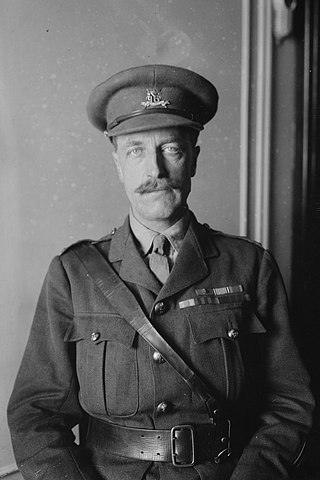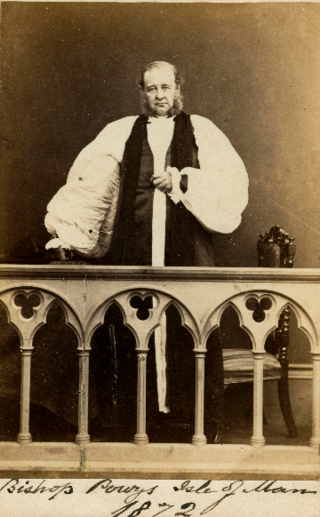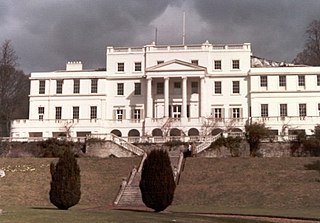
Potters Bar is a town in Hertfordshire, England, 13 miles (21 km) north of central London. In 2011, it had a population of 21,882. In the 2021 census, the four wards that make up Potters Bar - Bentley Heath & The Royds, Furzefield, Oakmere and Parkfield - had a combined population of 22,536; this includes several smaller outlying hamlets contained in the Bentley Heath & The Royds ward, such as Bentley Heath and Ganwick Corner. In 2022, the population was around 23,325.

Baron Walpole of Walpole in the County of Norfolk is a title in the Peerage of Great Britain.

Alexander Edward Murray, 8th Earl of Dunmore, known by the courtesy title Viscount Fincastle until 1907, was a Scottish peer, soldier and politician.

Samuel Hood, 2nd Baron Bridport, of Redlynch House in Wiltshire, of Cricket House at Cricket St Thomas in Somerset, and of 12 Wimpole Street in Westminster, was a British politician and peer.

Potters Bar Urban District was a local government district in England from 1894 to 1974, covering the town of Potters Bar and the village of South Mimms. The district was initially called the South Mimms Rural District, being renamed in 1934.

Sir Horatio (Horace) Mann, 2nd Baronet was a British politician who sat in the House of Commons between 1774 and 1807. He is remembered as a member of the Hambledon Club in Hampshire and a patron of Kent cricket. He was an occasional player but rarely in first-class matches.

Pishiobury, sometimes spelled Pishobury, was a manor and estate in medieval Sawbridgeworth, Hertfordshire. Its denomination as "Pishiobury" only emerged in the mid to late 19th century.

Charlotte Mary Hood, Baroness Bridport, 3rd Duchess of Bronte was an English aristocrat who inherited an Italian dukedom and estate between Bronte and Maniace in Sicily.

Charles Adolphus Murray, 7th Earl of Dunmore VD DL, styled Viscount Fincastle from birth until 1845, was a Scottish peer, Conservative politician, explorer, author, and artist.

Horatio Powys was a priest in the Church of England and Bishop of Sodor and Man.

Charles Murray, 1st Earl of Dunmore PC was a British peer, previously Lord Charles Murray.

First Church in Boston is a Unitarian Universalist Church founded in 1630 by John Winthrop's original Puritan settlement in Boston, Massachusetts. The current building, located on 66 Marlborough Street in the Back Bay neighborhood, was designed by Paul Rudolph in a modernist style after a fire in 1968. It incorporates part of the earlier gothic revival building designed by William Robert Ware and Henry Van Brunt in 1867. The church has long been associated with Harvard University.
Flight Lieutenant Edmund Roger Tempest was a British First World War flying ace credited with 17 aerial victories.

Linton Park, formerly Linton Place or Linton Hall, is a large 18th-century country house in Linton, Kent, England. Built by Robert Mann in 1730 to replace a much earlier building called 'Capell's Court', the estate passed through the ownership of several members of Mann's family before coming into the Cornwallis family. The house was enlarged to its current size in 1825.

Underley Hall is a large country house near Kirkby Lonsdale in Cumbria. It was designed in a Jacobean Revival style by the architect George Webster for Alexander Nowell and built between 1825 and 1828, on the site of an earlier house. An additional wing and tower, designed by E. G. Paley and Hubert Austin, were added in 1874.

Ellwood Manor is the Georgian-style home completed c. 1790 by William Jones, formerly in Spotsylvania County, Virginia but now in Orange County, Virginia. For more than a century, it was the center of a large, thriving plantation not far from the Chancellorsville crossroads on the Plank Road between Fredericksburg and Orange, Virginia which is now Virginia State Route 3. Not long before the American Civil War, J. Horace Lacy married William Jones' younger daughter and inherited both Ellwood and Chatham Manor.
Major Wulstan Joseph Tempest, was a British First World War pilot with the Royal Flying Corps and Royal Air Force. He was celebrated for shooting down a Zeppelin R Class airship over Potters Bar in October 1916.

Richard Chauncey or Chauncy (1690--1760) was a London merchant who was four times the Deputy-Chairman of the East India Company and three times the Chairman.

LZ 72 was an R Class super-zeppelin belonging to the Imperial German Navy. It was commanded by Kapitänleutnant Heinrich Mathy, an experienced commander, and took part in several raids over London during World War I. It also participated in a reconnaissance role during the Sunderland raid of 19 August 1916. Its last flight was launched late at night on 1 October 1916. Several miles north of London, it was caught in searchlights and anti-aircraft fire. During this engagement, 2nd Lt. Wulstan J. Tempest was on patrol and spotted the zeppelin. He proceeded to engage the airship with incendiary rounds, causing the ship to burst into flames and crash in a field near Potter's Bar. The entire crew died, and were originally buried there but were reinterred at Cannock Chase German Military Cemetery in the 1960s. After this disastrous crash, the Imperial German Navy began reducing the number of zeppelin raids.

Carss Bush Park is a 20-hectare (50-acre) nature reserve and urban park located at 74 Carwar Avenue, in the Sydney suburb of Carss Park, Georges River Council, New South Wales, Australia.





















